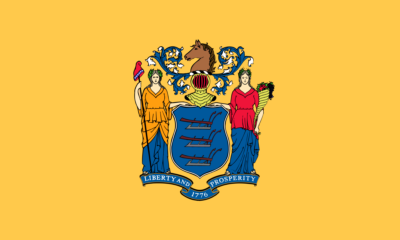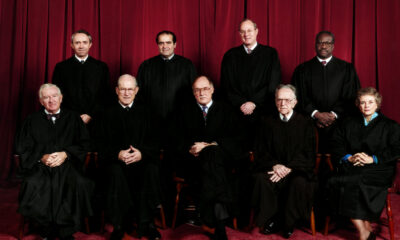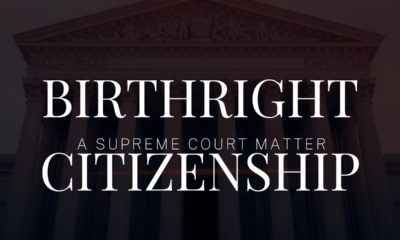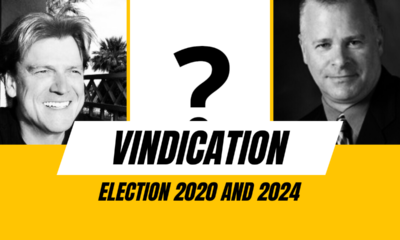Judicial
Dobbs draft leak – we might never know
The Supreme Court publicly admitted we might never know who perpetrated the Dobbs draft leak – because Court security is too lax.
Yesterday afternoon the Supreme Court of the United States issued a report of its investigation into the leak of Samuel A. Alito’s first-draft opinion in Dobbs v. Jackson Women’s Health Organization – the Dobbs draft leak. Unfortunately, the Marshal of the Court concludes that we may never know who leaked that draft. The Marshal admits that the Supreme Court simply does not adequately protect its confidential information, and trusts too many people. Sadly, this includes Court Members themselves, though the Marshal never says that. But from what the Marshal does say, one can readily see how some Justice, or his or her clerk, could have done the Dobbs draft leak.
Review – the Dobbs decision
The case of Dobbs v. Jackson Women’s Health Organization, 597 U.S. ___ (2022) reversed forty-nine years of ultra-permissiveness on abortion. In 1973 the Court held (Roe v. Wade, 410 U.S. 113)) essentially that a woman could terminate her pregnancy voluntarily, for any reason or no reason, until the unborn child became “viable.” A later case (Planned Parenthood of Southeastern Pennsylvania v. Casey, 505 U.S. 833) essentially said that Roe stands as decided.
Ever since then, several States watched carefully the ideological balance of the Court. This should never have become a “thing,” but after McCullough v. Maryland, Thomas Jefferson would observe that the Court itself made the Constitution “a mere thing of wax.” Nevertheless, States would try to regulate pregnancy ending on simple sanitary grounds. Or they would try to set time limits on the procedure, similar to those in nearly every other Western country. And the Court refused, and refused, and refused. That refusal explains in part why Texas passed its Heartbeat Act and relied on private citizens to bring civil action against pregnancy-ending practitioners.
Then in 2018, Mississippi passed its Gestational Age Act, to cut the procedure off after fifteen weeks. The Jackson (Mississippi) Women’s Health Organization sued Mississippi in federal court. They won at the District Court and in the Fifth Judicial Circuit. Thomas Dobbs, the Mississippi Health Commissioner, petitioned the U.S. Supreme Court for review – in 2020. The case came to oral argument on December1, 2021. (Docket No. 19-1392)
Arguments, votes, and the draft
The respondents, in their briefs and at argument, probably made a rhetorical mistake that cost them their case. Judith Rikelman, attorney for the respondents, insisted on the Roe standard, and stood on a basic “right” to abortion. Furthermore, she refused to concede that fifteen weeks was a reasonable time limit. Chief Justice Roberts said (and she did not contradict him) this time limit applied in many other countries. No matter. Amy Coney Barrett pointed out that “safe haven laws” (every State has one) can relieve a woman of the burden of motherhood. Again, no matter. But Clarence Thomas asked her whether her stand on “bodily autonomy” would let a woman skate on taking alcohol or other drugs before “viability.” And she was not willing to assert that. That made her position logically inconsistent.
What happened after Chief Justice John Roberts “submitted” the case at the close of oral argument? One can only speculate. Doubtless the Court held a preliminary vote. That vote must have come down 6-3 in favor of Commissioner Dobbs – but 5-4 in favor of explicitly overruling Roe. We do know that Samuel A. Alito produced a first draft Opinion of the Court, dated February 10, 2022. Furthermore, the Court accepted no further briefs. But the Court did accept a letter from the new Solicitor General of Virginia disavowing an amicus brief in which Virginia had joined. This was the California brief, submitted September 20, 2021, supporting the respondents.
The Dobbs Draft Leak
Then on May 2, 2022, Politico.com published a copy of Samuel A. Alito’s opinion – the Dobbs Draft Leak. The news hit the country like a thunderclap – because Alito clearly said he would overrule Roe and Casey both. Regular readers will recall that CNAV at first regarded the Dobbs Draft Leak as a fraud. But Chief Justice Roberts certified that the Dobbs Draft Leak was authentic. He also called for an investigation by the Marshal of the Court.
That leak must have prompted some on the “pro-choice” side to think they could change the Court’s mind. An organization calling itself ERA-NC Alliance actually tried to file an amicus brief on May 16, 2022. The Court refused four timesto file even a motion begging the Court’s leave to file such a brief late.
The Chief Justice insisted that the document was only a draft, and was not final. Nevertheless, when the judgment came down, it mirrored almost exactly the Dobbs Draft Leak. The only differences consisted of a minor change of phrase, and acknowledgments of dissenting and concurring opinions.
Statement by the Marshal of the Court
Yesterday the Court released a 23-page statement by the Marshal of the Court, together with Michael Chertoff’s group. That statement covered the Marshal’s investigation of the Dobbs Draft Leak, and Michael Chertoff’s opinion that the investigation was thorough. (Mr. Chertoff served as Secretary of Homeland Security in the George W. Bush administration, the second to hold that post.)
In essence, the Marshal says: we cannot know who leaked that draft. That is, no one can establish, by a preponderance of the evidence, who leaked it. The Marshal did find it “unlikely” that any outside person “hacked” the Court’s servers to get that hard copy. So the Marshal focused her full attention on the Court’s clerks and temporary and permanent staff. But the Marshal did not discuss any suspicion of any of the Court’s Members.
The Marshal admitted many weaknesses in the Court’s protection of sensitive information. Members and staff of the Court trust one another, so the Court has “limited safeguards” for its “very sensitive information.” Furthermore – and this could be the key – the COVID-19 Pandemic prompted the Court to let more staff work at home. They even issued printers to staff – and investigators tried to tease out printer logs from one such printer, without success. In brutal fact,
it was too easy to remove sensitive information from the building and the Court’s IT networks, increasing the risk of both deliberate and accidental disclosures of Court-sensitive information.
Security weaknesses that the Dobbs Draft Leak highlights
Staff and especially law clerks understand that they are handling confidential information. The Court’s Human Resources Manual and Law Clerk Code of Conduct reinforce this idea. Furthermore, this applies to someone leaving the employ of the Court. A law clerk especially receives instruction not even to tell a spouse what goes on in the Court.
But clearly, several employees did. That came out in the investigation – because they had to swear that they told their spouses but no one else.
Aside from the human security weakness that someone is lying without shame in the matter, the Marshal highlighted the information handling weaknesses. Among other things, the Court’s computer systems are out-of-date and will see an overhaul.
Your editor has worked with networked and stand-alone computers since the appearance of the first desktops and portables. This includes working with locally connected and network printers (also called “print servers”). Your editor also has training and/or experience with database administration and management, reading of error and event logs – and security. What follows is an evaluation of the Marshal’s Report, from the point of view of an experienced organizational information officer.
Forensic findings
Investigators don’t believe or don’t want to believe that anyone hacked the Court’s network or any server on it. Nor do they believe that anyone with senior administrative privileges “accessed or moved” the opinion.
The draft opinion had a rubber stamp on it, noting its first draft status and the date of circulation. Every public Court document is a PDF document. PDF documents can come from word-processing programs with PDF export options, print routines that offer “save as PDF” among available print devices, and – the key here – scanners. A document carrying a rubber stamp almost must be a scan. But we don’t know.
Eighty-two individuals, besides the Justices, had access to Alito’s opinion. We know who emailed the document to whom – with authorization. But did any recipient email the document to anyone else? We have no way to tell! “Limitations in the Court’s computer recordkeeping,” the Marshal says. Could they look at the event logs? Many of these logs do not even exist!
Thirty-four individuals admitted printing out hard copies – and four were “not sure.” And many of them admitted that they did not give the draft opinion the consideration that sensitive information deserves.
Two different printer types
The Supreme Court still uses locally connected printers, in addition to network printers. Local printers notoriously forget what jobs they’ve handled beyond the most recent sixty. Network printers can generate logs – but the Court’s networks weren’t keeping them.
The Court issues laptop and tablet devices but not smartphones to its staff. If the investigators asked for call and text details and billing statements, all employees provided those. But again, the information was limited. Clearly the Court would have done better to issue smartphones to its staff, for Court business only.
Interviews revealed that some staff told spouses or similar “significant others” about their work generally – or about the Dobbs case. And some admitted handling the Alito draft in ways not up to the Court’s usual standards.
Speculation on motives for the Dobbs Draft Leak were rife, of course – even to naming some law clerks. Investigators found nothing to lend credence to any such speculation – so they say.
Summary of conclusions about the Dobbs draft leak
So what do we have? The Marshal has convinced herself – and probably with perfect justice – that this was no hack, but an inside job. (Either that, or carelessness of a phenomenal order in leaving a copy in a public space.) Whoever did the job, if job it was, got away with it because Court security was lacking. The Marshal named two key areas of vulnerability:
- Movement of hard-copy documents from the Courthouse to the homes of staff (or Court Members!), and
- No way to track print jobs on Court printers or copiers.
Nor, sadly, were these all.
So, under the heading of locking the barn door after the horse has bolted, the Marshal recommends:
- Limiting the number of people with access to Court-sensitive information and the printing of hard copies,
- Writing a universal policy on the handling of Court-sensitive information,
- Developing a better method of destroying Court-sensitive documents,
- Overhauling information security and especially the handling of case-related documents,
- Installing better print and copy logging and tracking mechanisms,
- Laying emphasis on confidentiality during training, and
- Supporting legislation to make any such future disclosure a federal offense.
To that, your editor would add: issue smartphones to Court staff for Court business only. Make them Bluetooth “pairable” for calls only – and make plain that driving to or from Court is an extension of one’s duties at the Courthouse, with all that goes with that.
Reaction
The public is treating the Marshal’s report on the Dobbs draft leak with open scorn. Here, for example, are Charlie Kirk’s statements:
One person, in reply, referred to his earlier article. He repeated his opinion that the Supreme Court knows exactly who was responsible, and doesn’t want to name him.
One person seemed to speculate that Justice Stephen A. Breyer was the source. His motive: revenge for someone forcing him to retire, to permit the elevation of Ketanji Brown Jackson to the Court.
Another suspects the Chief Justice, who wrote his concurrence after seeing the public reaction to the leak.
Still another person suspects a clerk for either Elena Kagan or Sonia Sotomayor. In which case the Chief Justice actually wants to protect that clerk’s reputation.
Almost no one suspects a conservative Justice – because such a Justice would have no apparent motive.
In fact we might never know. Either one of the Justices sprung this leak – which seems incredible – or someone, perhaps even a law clerk, lied without shame. They did this because the Court was far too trusting in its handling of confidential information.
Security is about whom you trust, how far, and with what. The Supreme Court trusted people too far. In fact, the novelist Michael Farris (Anonymous Tip), before he became an advocate for an Article Five Convention of States, suggested that the Court trusts its clerks too far. Maybe – and sadly, that goes for the Court’s staff.
Terry A. Hurlbut has been a student of politics, philosophy, and science for more than 35 years. He is a graduate of Yale College and has served as a physician-level laboratory administrator in a 250-bed community hospital. He also is a serious student of the Bible, is conversant in its two primary original languages, and has followed the creation-science movement closely since 1993.
-

 Civilization19 hours ago
Civilization19 hours agoDC Pipe Bomb Arrest Raises Questions About Christopher’s Wray’s FBI
-

 Executive4 days ago
Executive4 days agoThe Last Supper: New York’s Socialist Feast
-

 Civilization4 days ago
Civilization4 days agoYoo Hoo, VP Vance—Your Character is Showing!
-

 Civilization5 days ago
Civilization5 days agoIvory Tower Thinking and Narcotics Boats
-

 Guest Columns3 days ago
Guest Columns3 days agoCongressional Leaders See Far Higher Stock Returns Than Peers
-

 Civilization4 days ago
Civilization4 days agoFacing Facts & Rolling Back Mythologies: The New National Security Strategy
-

 Civilization2 days ago
Civilization2 days agoThe Legal Logic Behind U.S. Operations Against Narco-Terrorist Networks
-

 Civilization3 days ago
Civilization3 days agoHow Trump Changed America












